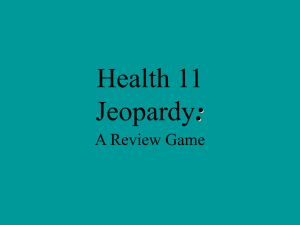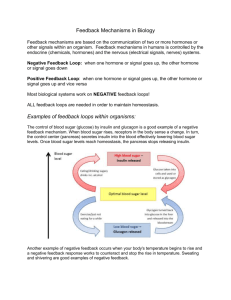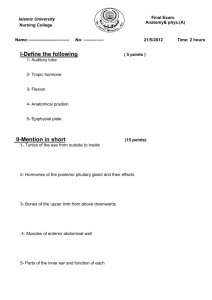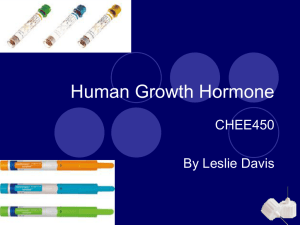ARE SHORT KIDS `SICK` - The Foundation on Economic Trends
advertisement
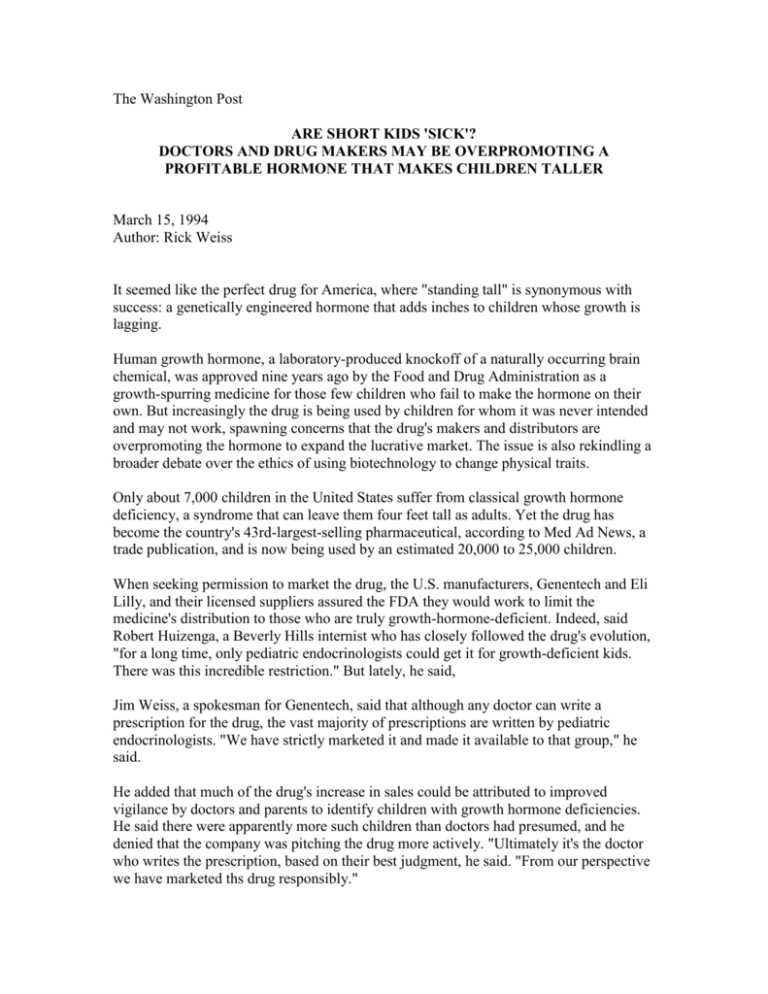
The Washington Post
ARE SHORT KIDS 'SICK'?
DOCTORS AND DRUG MAKERS MAY BE OVERPROMOTING A
PROFITABLE HORMONE THAT MAKES CHILDREN TALLER
March 15, 1994
Author: Rick Weiss
It seemed like the perfect drug for America, where "standing tall" is synonymous with
success: a genetically engineered hormone that adds inches to children whose growth is
lagging.
Human growth hormone, a laboratory-produced knockoff of a naturally occurring brain
chemical, was approved nine years ago by the Food and Drug Administration as a
growth-spurring medicine for those few children who fail to make the hormone on their
own. But increasingly the drug is being used by children for whom it was never intended
and may not work, spawning concerns that the drug's makers and distributors are
overpromoting the hormone to expand the lucrative market. The issue is also rekindling a
broader debate over the ethics of using biotechnology to change physical traits.
Only about 7,000 children in the United States suffer from classical growth hormone
deficiency, a syndrome that can leave them four feet tall as adults. Yet the drug has
become the country's 43rd-largest-selling pharmaceutical, according to Med Ad News, a
trade publication, and is now being used by an estimated 20,000 to 25,000 children.
When seeking permission to market the drug, the U.S. manufacturers, Genentech and Eli
Lilly, and their licensed suppliers assured the FDA they would work to limit the
medicine's distribution to those who are truly growth-hormone-deficient. Indeed, said
Robert Huizenga, a Beverly Hills internist who has closely followed the drug's evolution,
"for a long time, only pediatric endocrinologists could get it for growth-deficient kids.
There was this incredible restriction." But lately, he said,
Jim Weiss, a spokesman for Genentech, said that although any doctor can write a
prescription for the drug, the vast majority of prescriptions are written by pediatric
endocrinologists. "We have strictly marketed it and made it available to that group," he
said.
He added that much of the drug's increase in sales could be attributed to improved
vigilance by doctors and parents to identify children with growth hormone deficiencies.
He said there were apparently more such children than doctors had presumed, and he
denied that the company was pitching the drug more actively. "Ultimately it's the doctor
who writes the prescription, based on their best judgment, he said. "From our perspective
we have marketed ths drug responsibly."
Also drawing fire are financial contributions from the hormone's makers to two nonprofit
foundations that focus on growth disorders, with critics contending that the foundations
are being used by the companies as tools to expand the growth hormone market. Among
other things, the foundations have organized large-scale screening programs in schools to
identify short children and to notify parents of the possible need to see a doctor. One has
produced public service announcements for television making the point that short stature
is often a treatable disease. Foundation officials said they are not promoting the drug but
are trying to help identify children who might otherwise not get support and treatment
they need.
Industry observers have worried from the start that the drug, which costs $10,000 to
$20,000 or more a year, might get prescribed for children who are short for reasons other
than hormone deficiency -- or even for medium-sized kids -- even though it has not been
shown to add to these children's final height. Concerns about the potential for abuse rose
last week with the expiration of a seven-year marketing monopoly held by Genentech and
Lilly. Three other companies are prepared to enter the market, and experts expect the
competition to prompt a drop in prices and increase access to the drug. Already, the
hormone has found a black-market following among high school and professional
athletes as a body-building drug. The fear is that a combination of aggressive marketing
practices and cheaper and easier access to the drug could soon add up to a major problem
of overuse.
The situation is complicated because new methods of testing for growth hormone
production show that the term "deficiency" can be open to interpretation. Indeed, said
Brian Stabler, a professor of psychology and pediatrics at the University of North
Carolina, the old definition of growth hormone deficiency had been rather arbitrary.
Now, he said, "nobody in pediatric endocrinology has agreed on what the cutoff of
normal should be."
At the same time, preliminary studies suggest that the hormone may in fact be a useful
treatment for more growth conditions than had originally been assumed. In one
unexpected application, it clearly adds to the final height of children who are short due to
chronic kidney disease. It even speeds growth in some short children who do not fit
anyone's definition of having a growth hormone deficiency. But it will be years before
doctors know for certain whether these children actually end up tallerthan they would
have or if they are simply reaching their adult height a little bit sooner. Long-term side
effects of hormone supplements for these children, if there are any, may not show up for
years.
Some parents aren't waiting to find out. Robert and Annette Bursley of Collins, Ohio, had
their preschooler David checked out when it became clear to them he was not growing as
fast as his peers. Tests showed he was not deficient in growth hormone, and doctors
presumed his short stature was a family trait (his father is 5-10; his mother is 5-1). With a
predicted final height of less than five feet, his doctor offered the possibility of growth
hormone shots.
"It was a hard decision to make," said his mother, who was concerned that the
combination of her son being very short and also having a mild speech disorder might
cause him problems as an adult. "I was so worried about his being extremely short and it
being hard to get a job, we went ahead and did it." Her insurance from work has paid the
bills of more than $30,000 per year.
Now, at age 14, after taking six shots a week for more than six years, David is 4-10 and
growing at a rate just below average for his age. No one can say for sure if he would have
grown that much anyway -- many children get a late start growing. But his parents are
convinced he's taller than he would have been without the hormone, and plan to continue
treatment for a few more years. "We're thrilled," his mother said.
A Call for Restrictions
In response to such expanded use of the drug, a consumer watchdog group plans this
month to file a petition with the federal Drug Enforcement Administration to reclassify
human growth hormone as a controlled substance like cocaine or morphine, effectively
limiting its use to those few individuals for whom the hormone was originally approved.
Government restriction would be a blow to Genentech and Lilly, which last year rang up
about $300 million in U.S. sales of the hormone -- much of it, company representatives
confirm, for use in children who do not meet the strict definition of growth hormone
deficiency. Restrictions could also make the drug more difficult to obtain by parents of
children who clearly have such a deficiency.
But advocates of tighter government restrictions said they are the only way to prevent a
blurring of the line between medical treatment and social engineering. "We're looking at
the possibility of drugs being used to change anything that society deems unfit," said
Jeremy Rifkin, president of the Foundation on Economic Trends, the Washington-based
advocacy group that is filing the DEA petition. "When society goes for the quick fix and
chooses to engineer the victim so he conforms to society's view of perfection, then we
have changed in a fundamental way the social contract between individuals and society."
Whatever the fate of human growth hormone, experts said, the debate is a harbinger of
dilemmas to come as biotechnology produces new drugs that can alter the body's growth,
development and appearance. At issue are difficult questions about looking or being
different from one's peers and the extent to which individuals and society are willing to
mold themselves to a particular vision of "normal." In the case of height, everyone agrees
that growth hormone should be made available to childrenwho make virtually no growth
hormone and are destined to be extremely short. But nobody seems to agree on where to
draw the line on who else should be treated.
"The question is going to be, 'How healthy is healthy enough?' " said John Lantos, a
professor of pediatrics at the University of Chicago Pritzker School of Medicine. "There
is a whole industry of psycho-statural studies funded mostly by the drug companies to
document problems in school and problems in self-esteem and to target our hearts as well
as our minds to show us that shortness is a real disease. But how bad a self-esteem
problem do kids with big noses have? We could probably show that, so maybe we should
be getting them all nose jobs."
Overuse of human growth hormone was unthinkable before 1985. Until then, the only
way to treat children who couldn't make their own was to harvest tiny quantities of the
hormone from the brains of cadavers -- a painstaking endeavor with very low yields,
providing barely enough material to treat 400 patients a year. "We were blissfully
constrained by a limited supply," said David Wyatt, a pediatric endocrinologist at the
Medical College of Wisconsin.
Then, in 1985, Genentech produced a laboratory-grown version of the hormone, virtually
identical to the naturally occurring substance, and in 1987 Lilly entered the market. With
unlimited quantities assured, doctors began to wonder: Might extra doses of growth
hormone spur growth in short children with only slightly lowered growth hormone
production? Or in children who are short for reasons other than a lack of growth
hormone? Or in medium-height children who just want to be taller?
"The change in the supply allowed us to liberalize use of the drug," said Raymond Hintz,
head of the division of pediatric endocrinology at Stanford University.
Physicians are allowed by law to prescribe a drug for purposes other than those for which
it was approved. But some doctors and industry observers said they are concerned that at
scientific meetings and doctor's offices pharmaceutical representatives may be fostering
too much of a climate of "Try it, you'll like it" for a wide variety of growth disorders, few
of which have been proven to respond to the hormone. "There is . . . some encouragement
from drug company representatives," said Val Abbassi, director of pediatric
endocrinology at Georgetown University. "There is no question they have a role in
encouraging endocrinologists to try these new approaches."
The result has been a boom in prescriptions. Geoffrey Redmond, a pediatric
endocrinologist in Cleveland, has treated hundreds of children in the past 20 years, using
television ads, radio announcements and talk shows to "educate the public" about growth
disorders and their treatment. He doesn't require every recipient of the drug to be growth
hormone deficient, he said, because he has seen that others often respond as well.
"It's a very political issue," he said. "I feel the debate should focus on at what height
shortness is a real problem. I think for a male, 5-5 or 5-6 is the cutoff. Someone 5-7
might wish he were taller, but it's not really a big problem."
School Programs
Adding to the controversy are the efforts by two nonprofit corporations, the Human
Growth Foundation based in Falls Church and the MAGIC Foundation of Oak Park, Ill.
Their goals are to provide education and support for short children and their parents,
according to their brochures.
The foundations -- made up mostly of parents of children with growth disorders -together have received more than half a million dollars in contributions in the past several
years from the companies that make and distribute growth hormone, according to tax
documents and interviews. In the mid-1980s, the Human Growth Foundation's board of
directors included several representatives from the companies that make the drug.
Pharmaceutical representatives no longer sit on the Human Growth Foundation's board of
directors, said Fran Price, the foundation's executive director, but they remain among the
foundation's "directors at large," a group of nonvoting advisers.
Of the foundations' activities, the school screening programs are among the most hotly
debated. In the past few years, the Human Growth Foundation has organized annual
height-and-weight-measurement programs for tens of thousands of students in Atlanta,
Albuquerque, Charlotte and Pittsburgh.
Genentech provides stadiometers -- height-measuring devices that attach to a wall -- and
growth charts that allow school employees to plot each child's growth relative to others.
Parents of all children falling into the lowest 5 percent are sent notices on foundation
stationery stating their child's height is "below normal range." The letter says, "If short
stature is due to a medical problem and is identified early, most children can be helped. If
you are concerned about your child's growth or weight, your child's physician should be
consulted."
The program has been criticized by parents and physicians on a number of grounds,
including its labeling as "abnormal" the shortest 5 percent of children without taking into
account parental height.
"They gave us their dog-and-pony show," said John Towle, whose son was flagged as a
slow grower a few years ago in Atlanta, resulting in an office visit to a pediatric
endocrinologist who, Towle said, seemed overanxious to prescribe the hormone. "He
said, 'Don't you want your son to be 5 foot 10?' and I said, 'Can you guarantee it?' and he
said, 'Well, no,' " said Towle, whose wife is 5 foot 1 and whose parents are shorter than
five feet. "He never said anything about possible side effects and wanted to do $1,800 of
testing. At that point, I just told him to pack sand."
Some physicians too are opposed to the school-based approach. "Schools are not the
place to be screening for growth problems and growth hormone deficiency," said
Georgetown's Abbassi, who said he'd rejected overtures to help create such a program in
the Washington area. "Most of us will not fall for these kinds of things."
Abbassi and others said the vast majority of children in the shortest fifth percentile are
not growth-hormone-deficient, and the implication of a medical problem could add to the
perceived psychological difficulties of being short. Still, even the foundation's worst
critics said they don't see its members as pharmaceutical conspirators but as wellmeaning parents who may be a little naive about the way they are helping to expand the
growth hormone market.
"Hopefully, {the school program is} not scaring too many people," said Karen Truto, a
salaried health educator with the Human Growth Foundation who helped organize the
Atlanta program, which sends abnormal height notices to between 750 and 1,000 kids
each year. "Normal can mean lots of things," Truto said. "These are the guidelines for
normal that have been given to us by experts."
Short Is Okay
Some school districts have rebuffed the foundation's efforts to initiate screenings,
questioning the program's scientific rationale. Elsewhere, administrators have expressed
surprise to learn that the foundations conducting the screenings are largely funded by
companies that make a drug to treat short stature.
"Genentech's name is on the growth charts, but as far as what Genentech was I wasn't
aware of the scope of their involvement in this business," said Mike Tenoschok, the
supervisor of kindergarten through 12th grade for the Cobb County board of education in
Atlanta.
But in light of cutbacks in school nursing programs, some administrators felt they
couldn't pass up a chance for free equipment and labor. "How could we say no?" said
Tenoschok's predecessor, Bob Moore, who gave the okay for the program to start in
1991. "It wasn't costing the school system a dime, and it might identify schoolchildren
who might need some help."
According to the foundation, screenings have identified several students with serious
disorders including thyroid problems and brain tumors. Since there is no follow-up of
parents who receive notices, however, there is no way to know how many children
actually prove to have growth disorders.
An advertisement used by the Human Growth Foundation to attract contributions during
last year's United Way campaign has also proved controversial. The ad showed a small
child cowering in a corner at school while two tall shadows loom menacingly over him.
"Growing pains can be worse for some kids," the ad said, offering a message of fear that
seemed not in keeping with the foundation's philosophy as presented in one of its
booklets, "Short & OK."
Executive director Price said the ad was created by an outside graphic artist "who wasn't
really familiar with the image we are trying to project." It was discontinued after the
United Way campaign came to a close.
More recently the foundation created two public service announcements that have yet to
be released. In one 60-second spot, Gary Coleman, the 26-year-old actor who stands 4
feet 10 because of a kidney disorder that today can be treated with some success with
growth hormone, first assures viewers that "good things come in small packages," but
then goes on to emphasize that short stature is a medical problem that can be treated. In
the other announcement, actress Linda Hunt presents a similar message.
In an interview last week, Coleman said he didn't know the foundation received funding
from growth hormone makers and wasn't concerned about it. "I personally don't have a
problem with drug companies financing a charity to help people grow."
Price said that growth hormone, although discussed in the foundation's literature, is never
mentioned in school screenings or in the television spots. "The Human Growth
Foundation does not promote the use of growth hormone," she said. "We promote healthy
children. We support parents regardless of the parents' decision."
Promising Science
Wyatt, of the Medical College of Wisconsin, said the growth hormone story is a story of
two forces at work. "Half of it is that Genentech is a great science company, a great
biotech company, and they've always listened to the endocrine community. And the other
half is the marketing half. They do a lot of things to expand the market. They throw that
net out and they only have to catch a couple of kids to get $50,000 a year."
Broad prescribing has also sown confusion in the insurance industry, which has found
itself having to deal with a growing number of very expensive reimbursement claims for
uses of growth hormone not generally recognized as appropriate.
"My feeling is there is abuse in the prescribing of it," said Alan Gold, a pharmacist at
New England Claims Analysts, a Boston-based company that works with insurance
companies to ferret out fraud and overbilling. Representatives from several insurance
companies said they had found it necessary to crack down on growth hormone claims.
An investigation into possible financial improprieties by the country's largest growth
hormone distributor has not helped the growth hormone industry's image. Northbrook,
Ill.-based Caremark International, the primary distributor of Genentech's human growth
hormone, which accounts for about 70 percent of the domestic market, has for 2 1/2 years
been the focus of a federal criminal investigation for possible Medicare fraud. At issue is
whether the company's reimbursement structure has amounted to a kickback system for
doctors who used its services or products.
The inquiry has recently expanded to see whether the company's growth hormone
business rewarded doctors for prescribing the hormone, according to a source familiar
with the investigation. A spokesman for Caremark said the company had fully cooperated
with the government investigation and believed the outcome would be favorable to the
company. He declined to comment on the possibility that growth hormone sales were also
under investigation.
Some doctors said that even if growth hormone only speeds up growth in slow-growing
children without adding inches to their final height, it could be worth the expense and
hassle of the injections. Stabler of North Carolina said studies have shown that many of
the behavioral problems that go along with short stature can be alleviated with growth
hormone treatments, apparently because the children are able to avoid the stigma of being
short during those childhood years when they are most sensitive to being teased.
But that is exactly the line that some believe marks the beginning of dangerous territory,
in which medicine is used to deal with what is essentially a social problem. They say
teachers and parents should be helping kids to accept themselves as they are, rather than
giving them drugs to make them "better." "As we use {growth hormone} in more and
more children and see that it may be working, it affects our ideas about what we want for
our children," said Wisconsin's Wyatt.
Some are more vehement. "I think this short stature stuff is just a load of crap to drum up
business," said Anne Fausto-Sterling, a professor of medical science at Brown University
who has followed growth hormone's rise in popularity with increasing dismay. "I've
watched this drug and this story work its way through the regulatory system and watched
us invent a disease state in people who are perfectly healthy."
Fausto-Sterling said she is especially concerned about the sexist assumptions implicit in
the informal decision by many U.S. doctors to treat boys with projected adult heights of
less than 5 feet 2 inches and girls with projected final heights of 4 feet 10 inches. "Here
we are making up what's normal and what isn't, we're literally rebuilding the curve of
height distribution, and what do we decide but that girls to be normal should be shorter
than boys," she said.
Wisconsin's Wyatt echoed Fausto-Sterling's concern. In the U.S., he said, "short girls are
petite. Short boys are shrimps."
Gary Coleman, the actor who appears on one of the Human Growth Foundation's public
service announcements, said he'd be concerned if it became too difficult for parents to get
human growth hormone for their very short children. He said his doctor has told him that
had the drug been available when the actor was growing up, he could be six or even 12
inches taller today.
As for those parents who might consider using it in children not especially short, he
seemed bemused. "To tell you the truth," he said, "I can't imagine anyone wanting to be
taller than five feet.
Caption:
Human Growth Hormone At a Glance
Hormones are compounds that are secreted by glands in the body and
transported by the blood to distant targets. Human growth hormone is a
hormone secreted by the pituitary gland near the base of the brain. It
has a range of positive effects on growth, development and metabolism.
In children, human growth hormone prompts the growth of bones and
other tissues; children who can't make the hormone fail to grow beyond
TKTK feet tall. In adulthood, the hormone helps maintain bone and muscle
mass and helps the body derive energy from food; tapering levels during
the final decades of life are probably responsible for some of the
hallmarks of aging, such as the drop in muscle and bone density and an
accumulation of fat.
The human growth hormone that is available as a drug by prescription
is virtually identical to the hormone made by the body. In the United
States, it is mass-produced in pharmaceutical company laboratories by
genetically engineered bacteria that contain copies of a gene for human
growth hormone. The hormone is typically injected three times a week
into the thigh with a tiny syringe
Copyright 1994 The Washington Post


